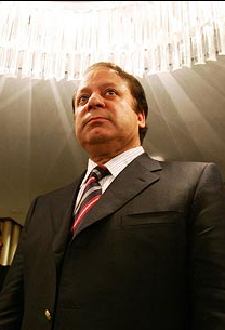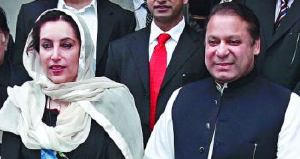 Adil Najam
Adil Najam
Former Prime Minister and PML(N) leader Nawaz Sharif is back in Pakistan.
Reportedly he landed in Lahore to a large reception by his supporters and was escorted to a special bullet proof car that had been brought for him. According to The News:
A special plane carrying the PML-N Chief Nawaz Sharif, his brother Shahbaz Sharif and other family members arrived in Lahore from the holy city of Madina on Sunday evening. The convoys of PML-N workers arrived in Lahore to accord rousing welcome to Sharifs. Large welcome banners and pictures of Sharif brothers have been displayed at several places in Lahore. The special plane Boeing777 carried Nawaz Sharif and Shahbaz Sharif along with 26 members of their family from the holy city of Madina.
The central and provincial leaders of PML-N, lawyers and members of civil society have arrived to receive Sharifs at Lahore Airport. Nawaz Sharif is expected to first visit Data Darbar in a procession and address a public meeting. Security had been tightened in Lahore especially on the airport ahead of arrival of the PML-N leader. Provincial home department has allowed only hundred party leaders to receive Sharifs at the airport, party sources claimed.
According to sources, bullet-proof cars for Sharifs reached in Lahore last night from Saudi Arabia. Meanwhile, the home department said that the authorities have decided to give free hand to Nawaz Sharif but he has not been permitted for holding a public meeting and rally.
Nawaz Sharif, Shahbaz Sharif and other family members will be transported to home from the airport, a home department statement said. However, thousands of PML-N workers succeeded in arriving airport by crossing the barricades put up by police. On this occasion, the workers raised slogans both in favour of Nawaz Sharif and against the government.
 Readers would remember from our prior posts that in August the Supreme Court of Pakistan had ruled that he could, in fact, return to Pakistan despite whatever ‘deal’ he had made with Gen. Musharraf at teh time of his original flight to Saudi Arabia. However, when he did return to the country in September, he was unceremoniously and dramatically deported back to Saudi Arabia with theatrics which rivaled his own attempts not to let Gen. Musharraf land in Pakistan many moons ago.
Readers would remember from our prior posts that in August the Supreme Court of Pakistan had ruled that he could, in fact, return to Pakistan despite whatever ‘deal’ he had made with Gen. Musharraf at teh time of his original flight to Saudi Arabia. However, when he did return to the country in September, he was unceremoniously and dramatically deported back to Saudi Arabia with theatrics which rivaled his own attempts not to let Gen. Musharraf land in Pakistan many moons ago.
Now it turns out that he has made yet another ‘deal’ with Gen. Musharraf which has enabled his return.
It is not fully clear what the ‘terms’ of this deal are. Nor what the Musharraf-Nawaz Sharif deal mean s for the earlier Musharraf-Benazir deal that had enabled her return some weeks back. Nor, in fact, is it clear what what his return (and the fact that now both Benazir and Nawaz Sharif are back in Pakistan) will mean for the future of Pakistan’s politics and the (supposed) forthcoming elections.
s for the earlier Musharraf-Benazir deal that had enabled her return some weeks back. Nor, in fact, is it clear what what his return (and the fact that now both Benazir and Nawaz Sharif are back in Pakistan) will mean for the future of Pakistan’s politics and the (supposed) forthcoming elections.
In despair, one even wonders if it means anything at all? Or is this just one more drama in the string of topi dramas that have come to define our distraught and fractured polity?




















































Jamshed Nazar says:
“In order to make a useful contribution to the productive economy, the 18+ year old must have some education / skills. My position is that we do not have resources in Pakistan to educate the existing amount of kids leave alone the millions more that are added every year. So, these kids grow up uneducated and the only work they can do is unskilled labor in the farms or in basic factories”.
“In summary, for sustainable development, we need to move up the skills ladder and start making more than cotton, wheat, carpets and towels etc”.
“The key is education, education, education and not population, population, population”.
Well said Jamshed Nazar. Here is an opportunity for the Upper Middle class of Pakistan to get involve and help educate those who can not do it on their own. Please, if you love Pakistan then do not wait for the government or for the democracy. Just get involved and do it. Pay for the school tuition of a child who is otherwise involved in child labor. Help send him to school. Please stop complaining and actually do something. Would you?
Adil, You are so biased that you see a deal here :S
Ahmad Shahid sahib!
In case of Japan, I do agree with you that its maturing population is resulting in stagnation of consumption levels nad hence there is a clear effect of economic stagnation for the last decade or even from 1994.
However, in case of Japan, there are other factors including over valued yen, loss of competitive advantages due to neighboring lower cost production in China, Taiwan, Malaysia etc. Also, Japan capitalized in its manufacturing acumen during the eighties like JIT manufacuturing etc and missed the boat on IT knowledge based industries that pumped up the US economy.
Regarding Germany, since I am current working here, I can tell you that the Germany economy is booming – look at the strength of the Euro. This does support your position in a way – Germany is hugely benefitting from the Eurozone low cost countries. My collegues in this high tech office are from Poland, Romania, Portugal, Italy etc. So, Germany is able to add working population by souring it from its Eurozone neighbors. (I am just temporarily here and planning to move).
However, I would again like to stress this position.
In order to make a useful contribution to the productive economy, the 18+ year old must have some education / skills. There is a huge financial investment required by society and the family in order to create a 22 year old engineering graduate who would add value to the economy for the next 40 – 50 years.
My position is that we do not have resources in Pakistan to educate the existing amount of kids leave alone the millions more that are added every year. So, these kids grow up educated and the only work they can do is unskilled labor in the farms or in basic factories.
You seem to be happy with the supply side of population. But then, there has to be demand also in the economy. Is the economy able to absorbs all these new additions and provide them jobs?
It is incorrect to compare a country like Pakistan with Iran – as in your previous post. Iran is sitting on huge oil reserves and has the money to pay for its population’s education / skills training. Pakistan is not hauling these black gold barrels out of the Gulf and thus needs to generate its resources from somewhere.
In summary, for sustainable development, we need to move up the skills ledder and start making more than cotten, wheat, carpets and towels etc. The goverment needs to figure out how we can make CDs, flatscreen tvs, memory cards, chemicals, plastics, aluminium / steel, ships, trains / planes – even basic mobile phones which are high value goods that will bring more money than suar cane or textile export.
Nokia – a company out of Finland – a speck of a country, is selling 50 billion dollar worth of cell phones every year – three times the export of Pakistan. How many Nokias do we have to show off from Pakistan?
If the economy would keep growing at 7+ percent for the next 20 years or so, maybe, just maybe, we might be able to make it seriously to the rank of middle income countries.
The key is education, education, education and not population, population, population.
Return of the Mahaaaa Loooter !
Jamshed Nazar:
Look at the growth rates over the last few years, specially since 1989 in Japan, and you would find that these two economies are the laggards. Economic growth is based on productivity and population growth. The US has grown since early 1990’s on the back of both but mainly productivity. Now these two economies, Germany and Japan, have reached the pinnacle of their growth and with shrinking populations they have shrinking markets and thus shrinking economies.
Housing is one of the sources of economic growth. As the house prices rise consumption rises and the economies grow. But one important factor for the house prices to rise is population growth. With negative population growth rates the house prices are less likely to rise. In fact since the house prices crash in 1989 in Japan, the house prices have gone down by almost 40% and the Japanese economy has performed poorly.
Your statistics are correct. Germany is the leading exporter in the world, with more than a trillion dollar exports, and Japan the second largest economy, around 5 trillion dollars. Germany’s GDP is around 3 trillion dollars. But countries like China are moving much faster. It would cross Germany this year and Japan in less than ten years within the next 10 years.
So what explains the drastic rise in GDP growth rates? There is a term known as the dependency ration: the ratio of people dependent on others (below 16, above 65) to those who are not dependent. Higher the dependency ration slower the growth and vice versa. Based on that a term is defined as the demographic dividend. When more people are betwen the ages of 16-65, least is the dependency ratio and productivity is higher. That is one of the many factors that contribute to productivity gains. In poor, less advanced countries, such as Pakistan, this contributes more to productivity than say IT.
Thus a large number of people below the age of 16 are about to enter the job market in Pakistan that would decrease the dependency ratio and boost the productivity. That would only help Pakistan grow more quickly and would also provide more resources to develop, human resource development, of 3 million odd people increasing each year.